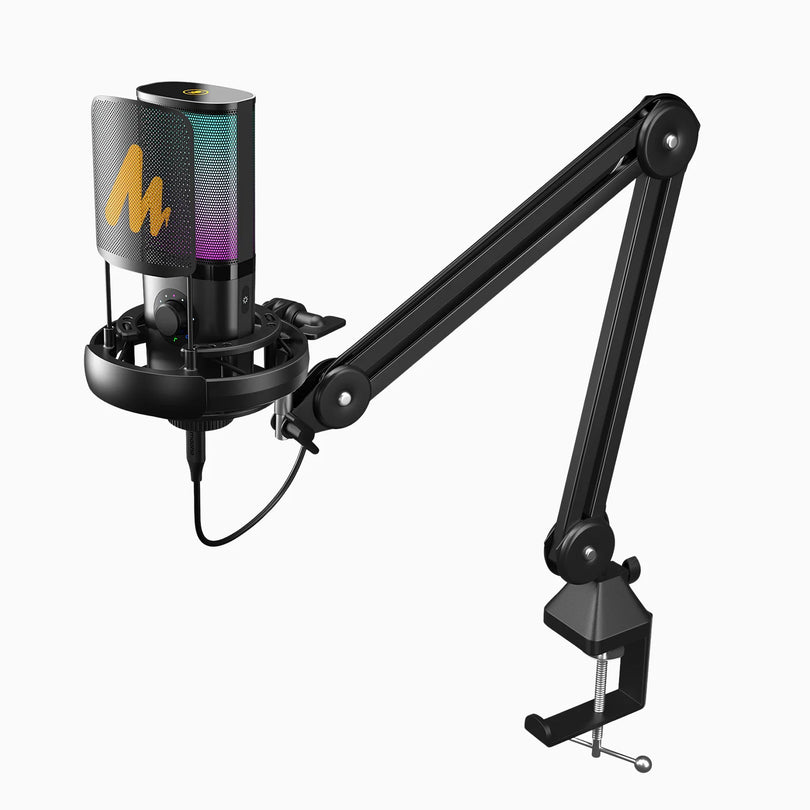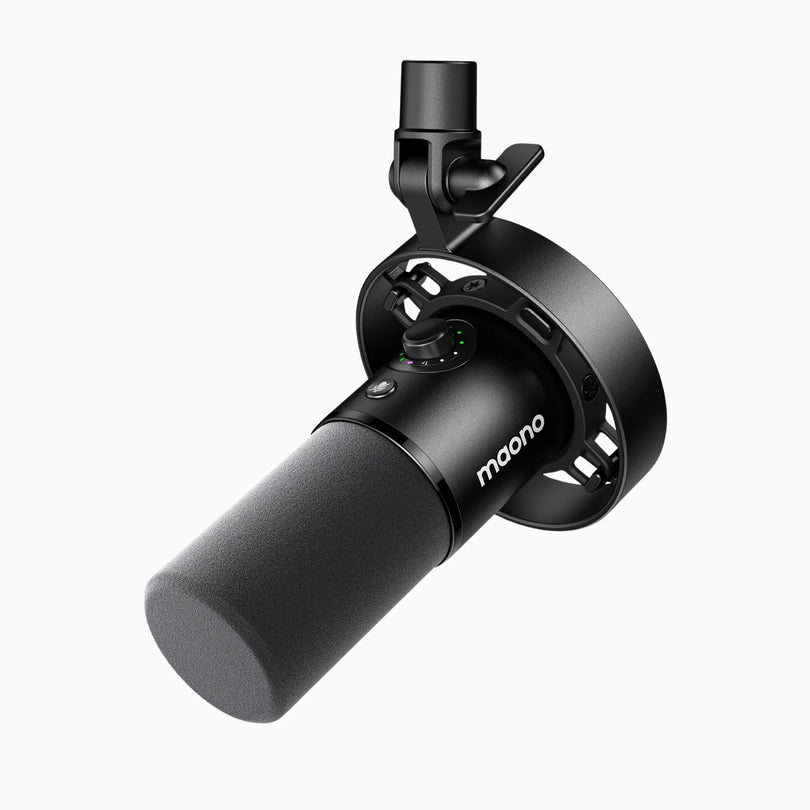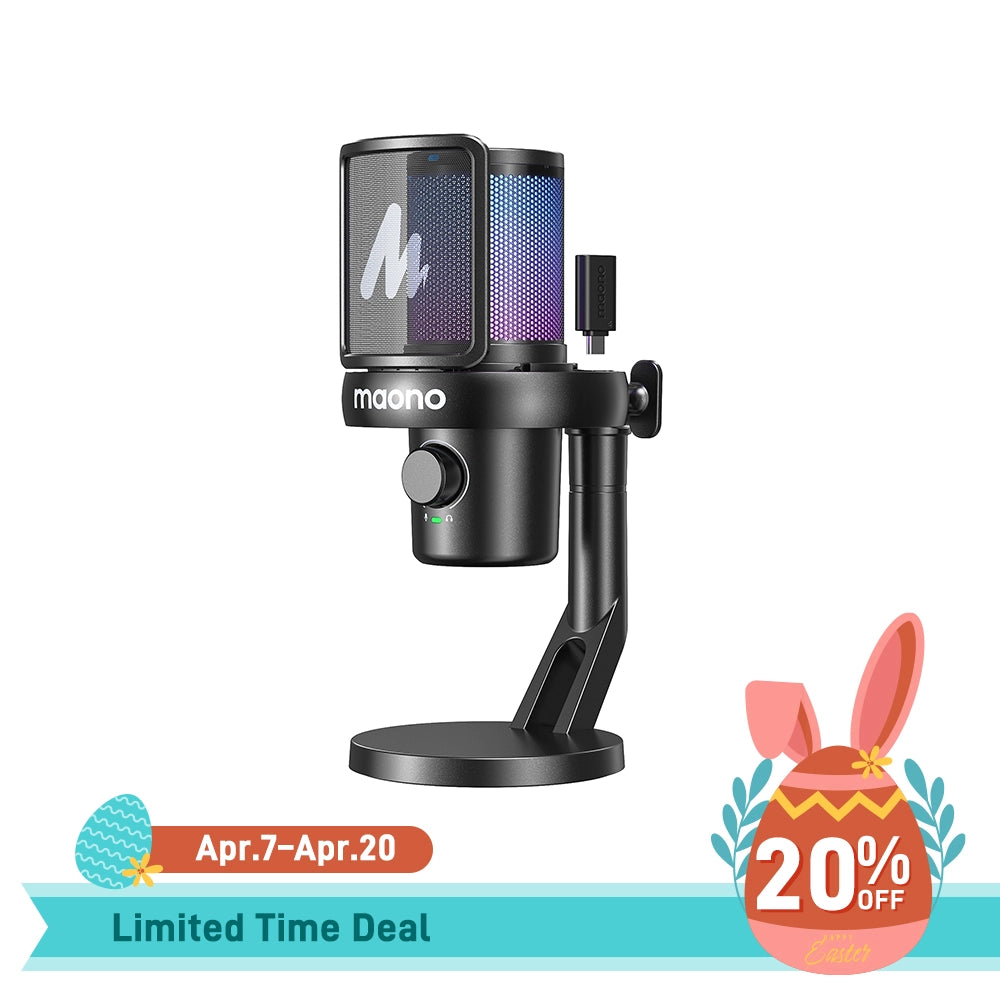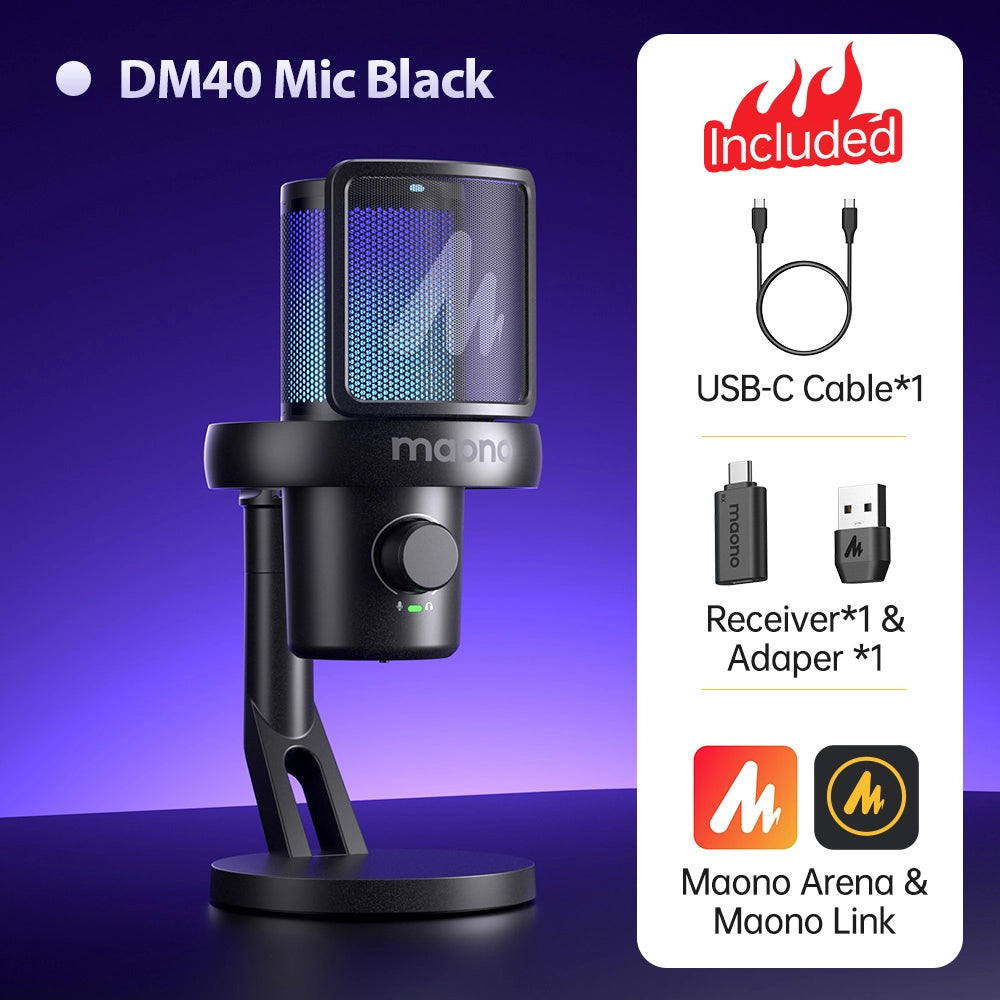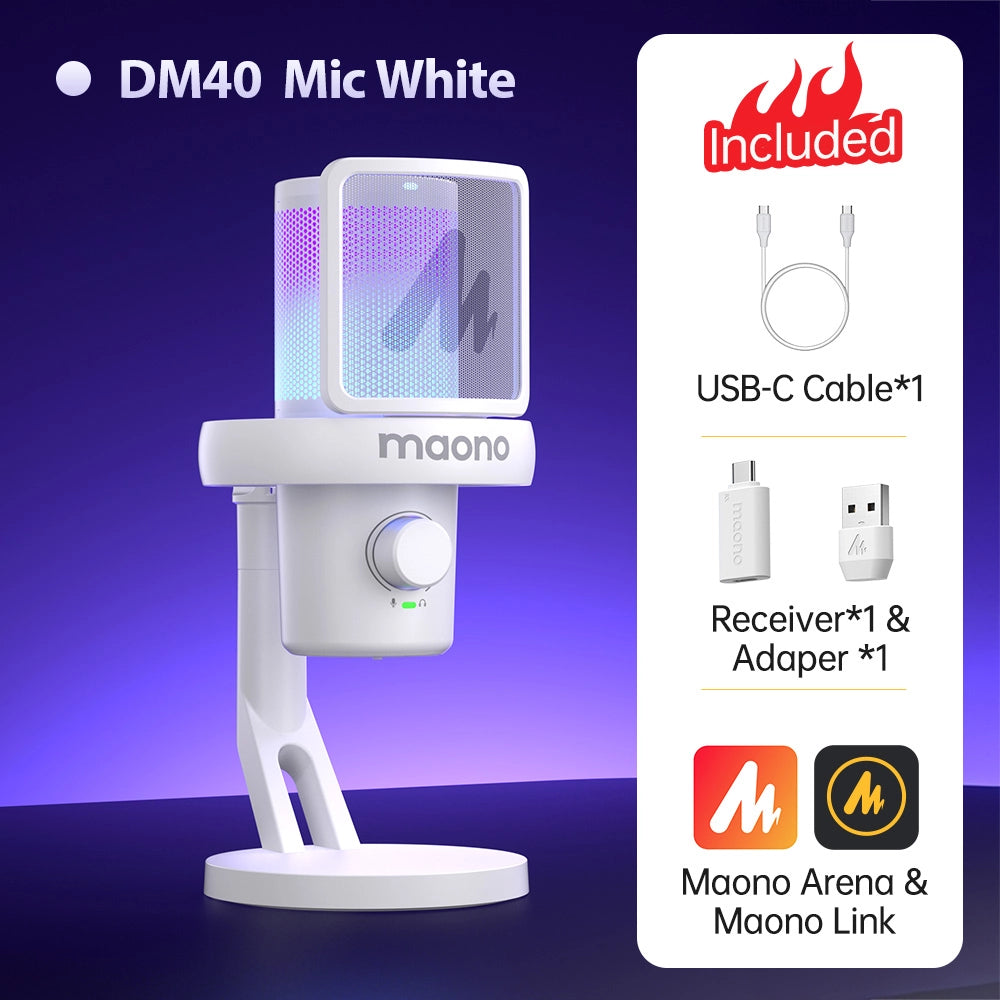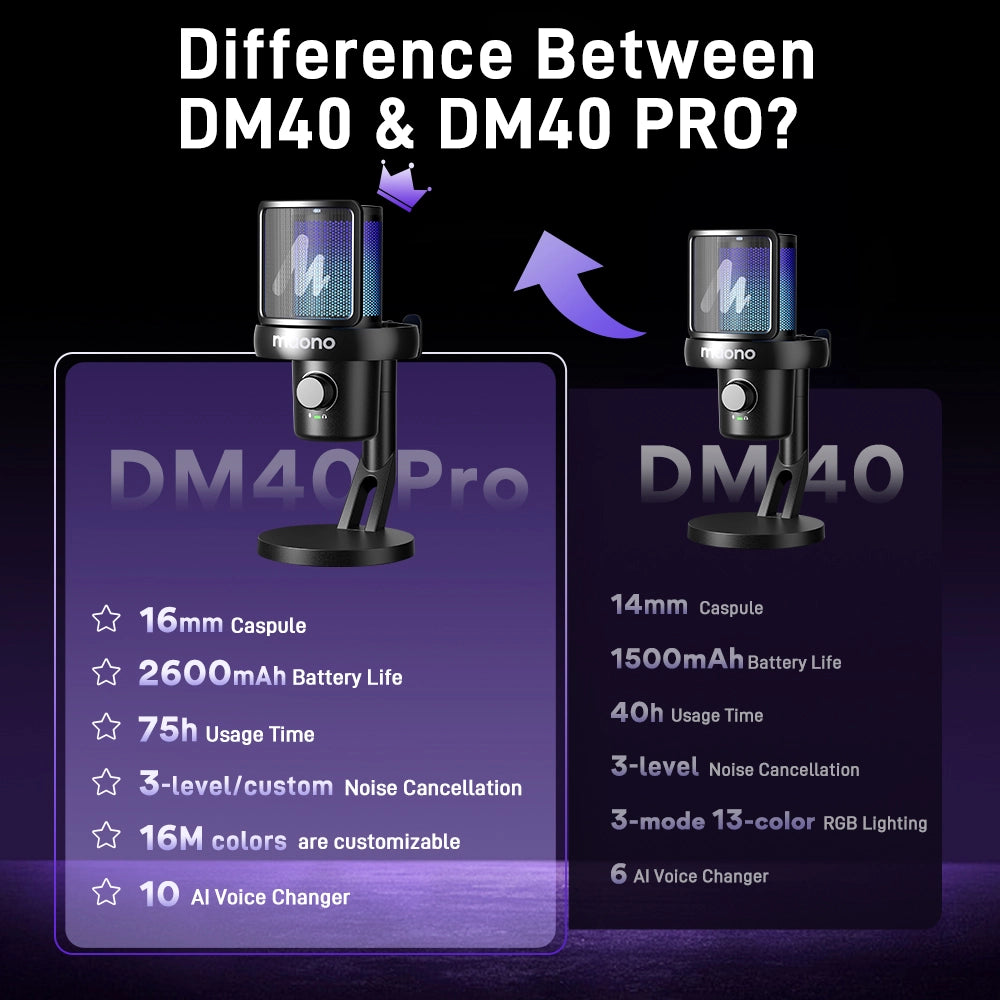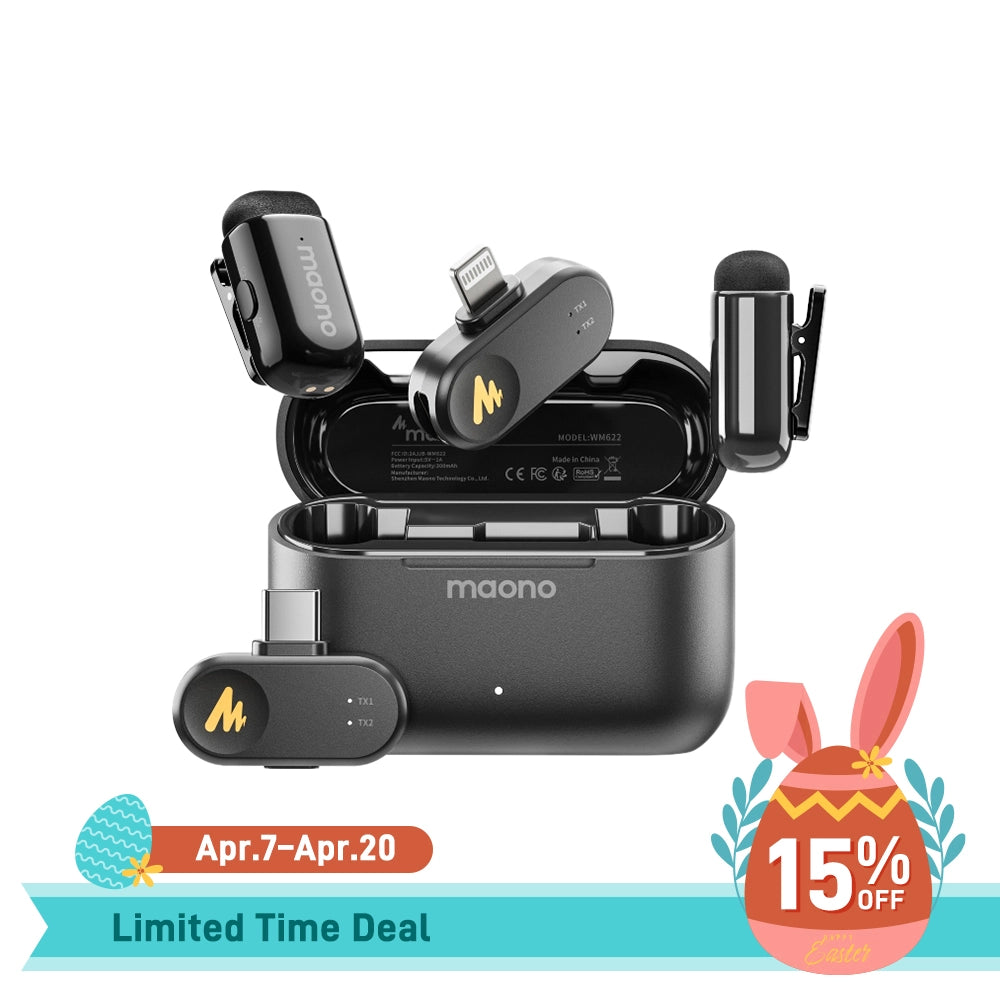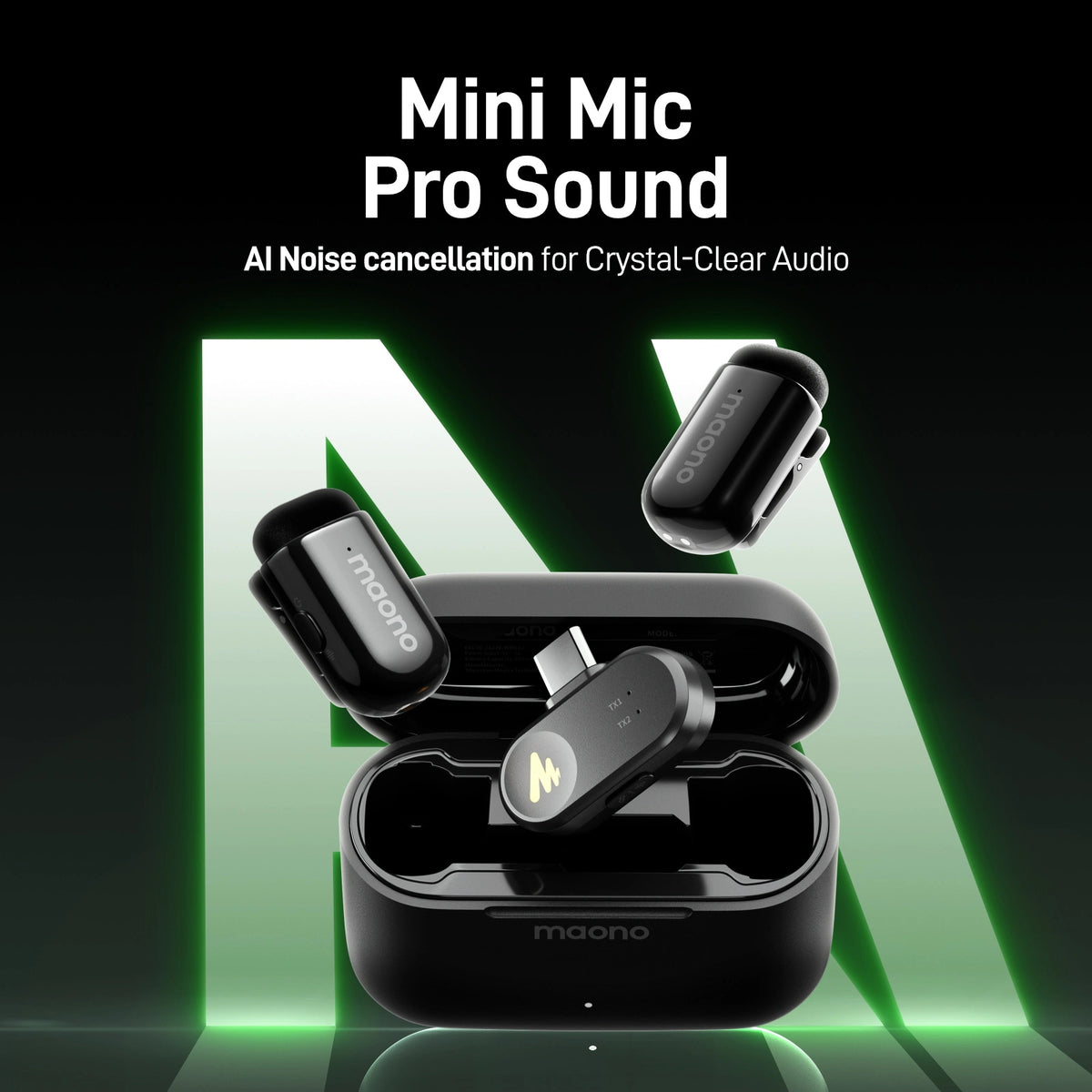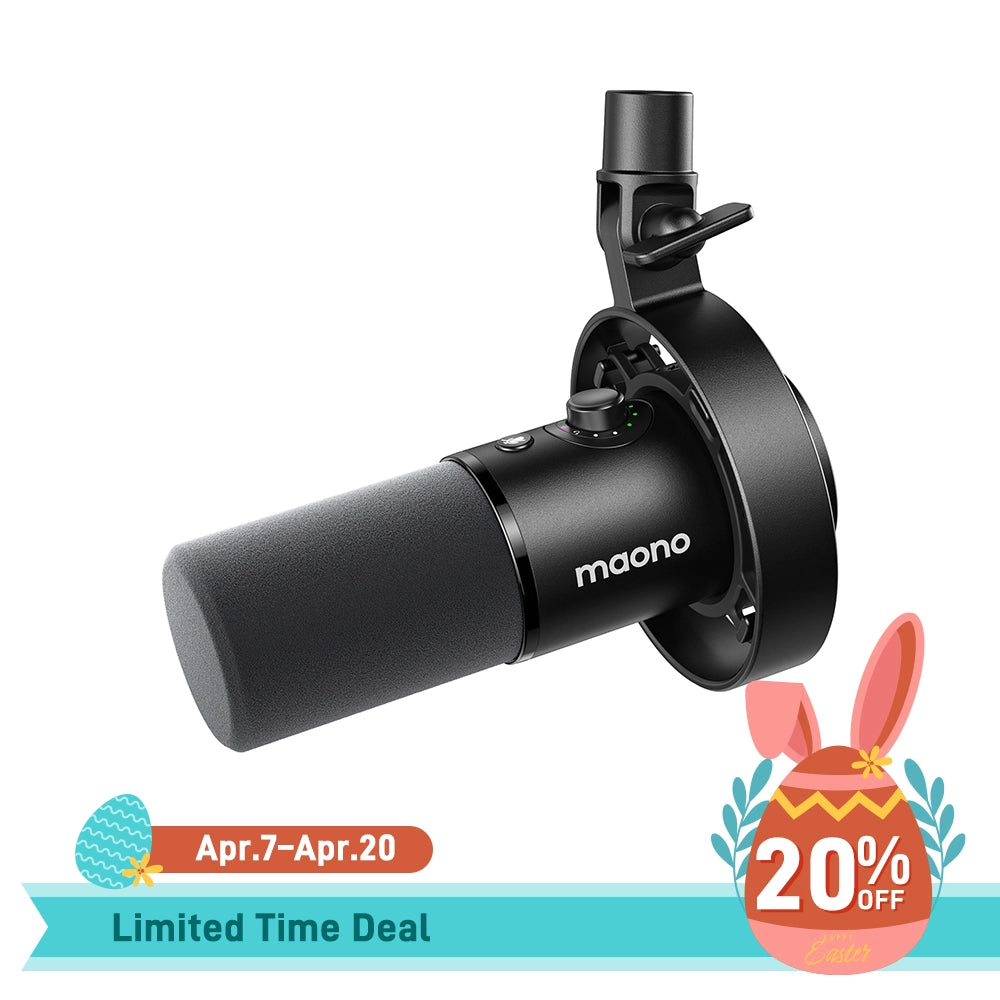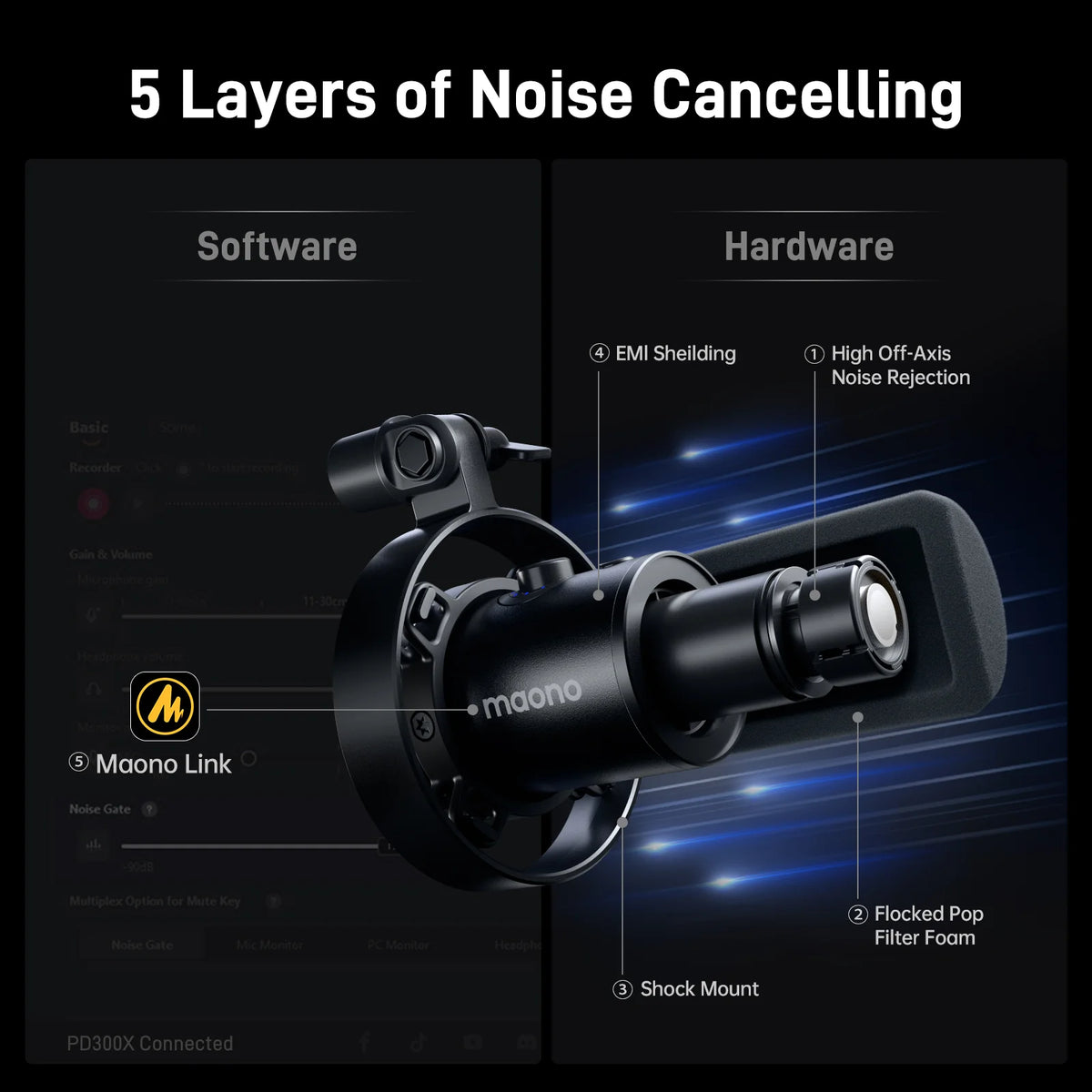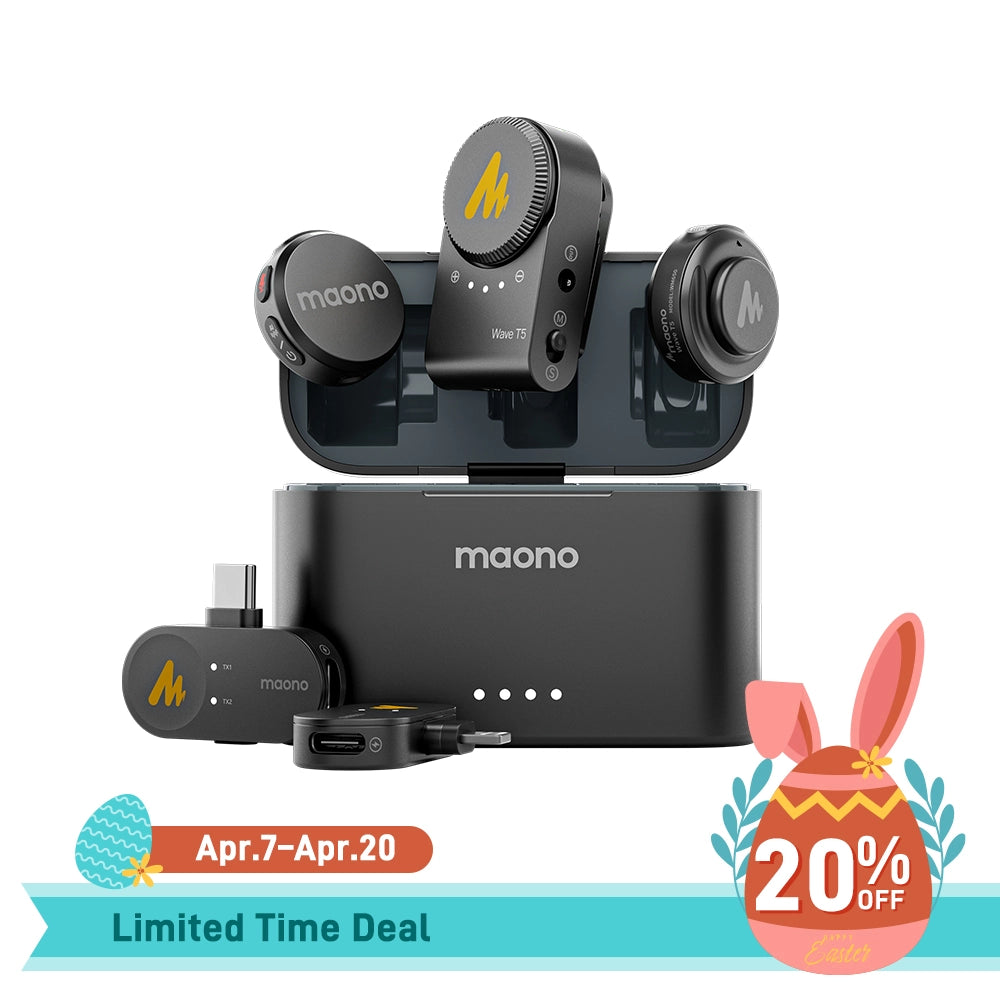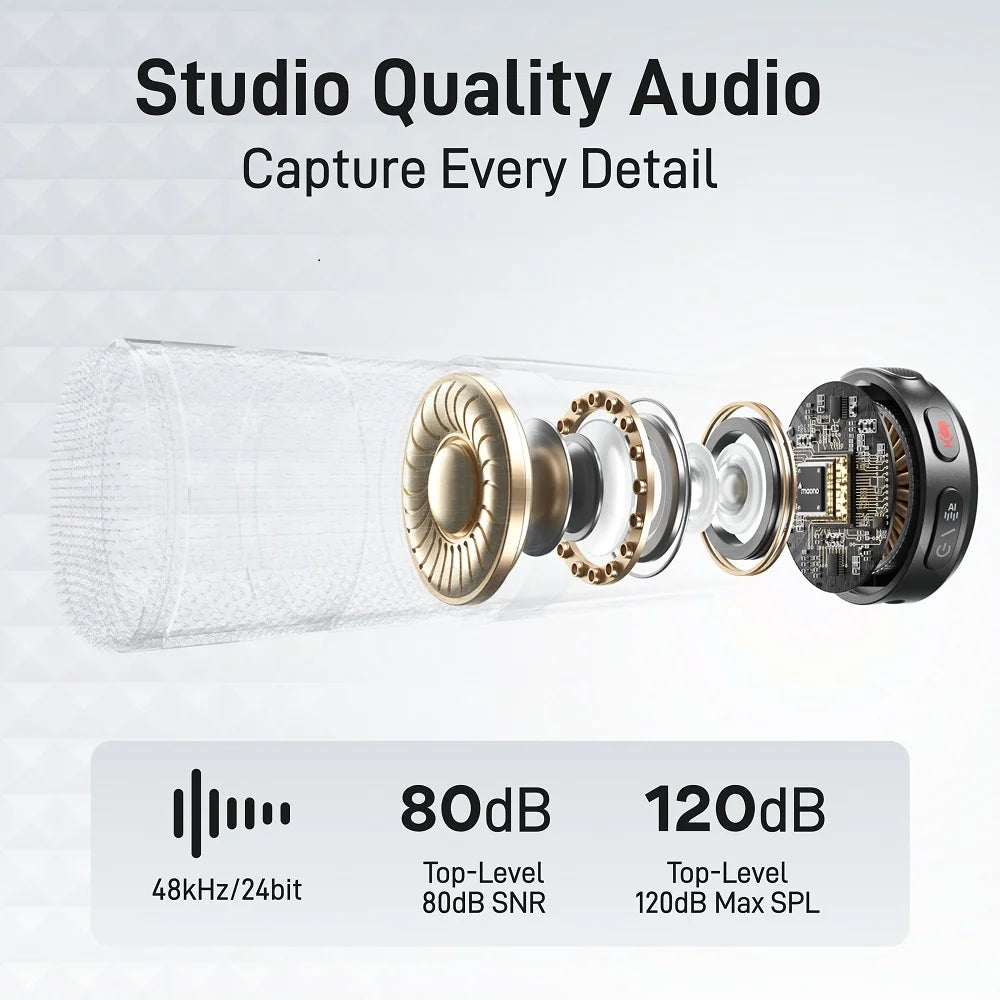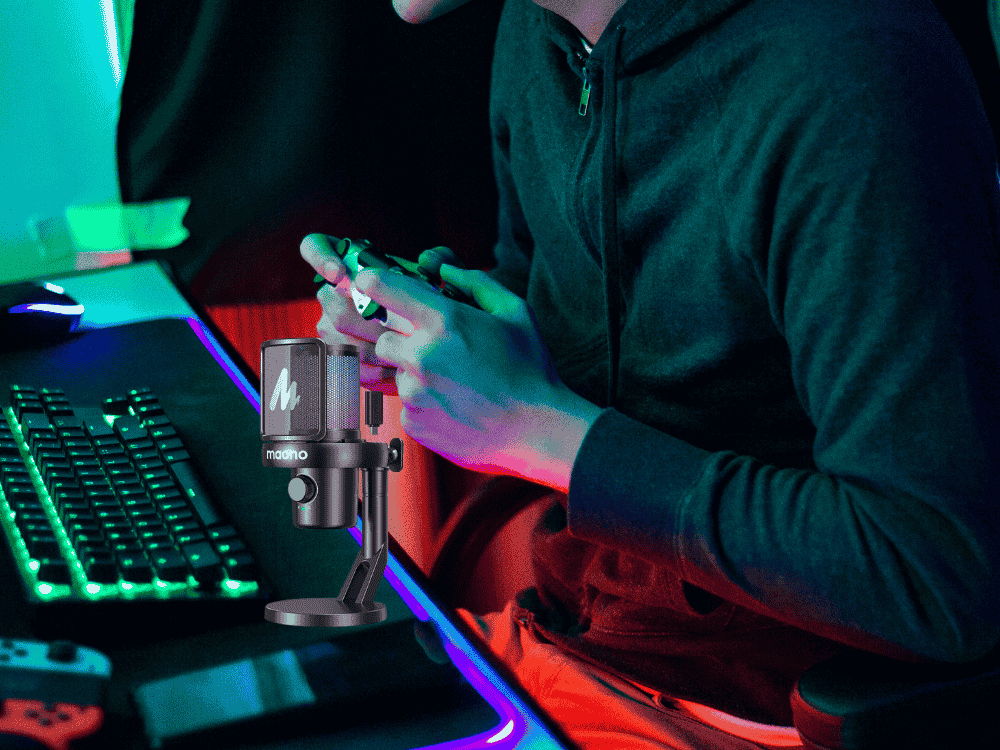A high-quality external gaming microphone is crucial when you decide to start live streaming. With the various options out there, it seems that choosing the best gaming microphone for a PC is a tedious task. Do you want to narrow down your choices? Whether you select a wired/wireless headset with microphone or a USB gaming microphone, the answer depends on your specific needs. If you're curious about how to connect an XLR mic to a PC and what specific brands of headsets and headphones use a 3.5 mm headphone and microphone connection using a jack, we also have you covered.
When it comes to live performance, choosing the right microphone is crucial for delivering clear and professional sound. This article compares headsets and USB gaming microphones to help you determine which is the best mic for live performance, ensuring you make an informed decision for optimal audio quality.

A wireless gaming headset or a headset microphone is headgear worn on the head and designed specifically for gamers.
A headset microphone is a type of headset that includes an integrated microphone and connects to a computer or other device via a USB (Universal Serial Bus) port or a 3.5 mm jack connector. These headsets are commonly used for activities that require both audio output (through the headphones) and audio input (through the microphone), such as gaming, video conferencing, online teaching, and streaming.
Key Features of Headset Microphones:
When choosing a headset for gaming, several key features can enhance your experience and performance. Here’s what to look for:
Audio Clarity: Look for headsets with high-quality sound that provides clear audio. This helps in identifying in-game sounds, such as footsteps or gunfire.
Surround Sound: Many gaming headsets offer virtual 7.1 surround sound, which improves spatial awareness and immersion.
2. Comfort:
Padding: Ensure the ear cushions and headband have ample padding and are comfortable for long gaming sessions.
Adjustability: The headset should be adjustable to fit different head sizes comfortably.
3. Microphone Quality:
Noise Cancellation: A noise-canceling or noise-isolating microphone helps reduce background noise and ensures clear communication with teammates.
4. Build Quality:
Durability: Choose a headset with a sturdy construction that can withstand extended use.
Material: High-quality materials, such as metal frames or reinforced cables, contribute to the headset’s longevity.
5. Connectivity:
Wired vs. Wireless: Decide whether you prefer a wired connection for potentially lower latency or a wireless headset for more freedom of movement. Wireless headsets should have reliable connectivity and good battery life.
6. Controls and Features:
In-Line Controls: On-ear controls for volume and microphone muting offer convenience.
Customizable Settings: Some headsets come with software that allows you to customize sound profiles, equalizer settings, and lighting effects.
7. Compatibility:
Platform Support: Ensure the headset is compatible with your gaming platform, whether it’s PC, Xbox, PlayStation, or other devices.
Connector Type: Check if the headset uses USB, 3.5 mm jack, or other connectors, and whether it needs any adapters.
8. Design and Aesthetics:
Style: Choose a design that fits your personal style and gaming setup. Some headsets come with RGB lighting or customizable accents.
Ergonomics: Consider headsets with a lightweight design and ergonomic features to prevent discomfort during extended play.
9. Price and Value:
Budget: Determine your budget and find a headset that offers the best value for your money, balancing features and price.
10. Brand and Reviews:
Reputation: Look for headsets from reputable brands known for their gaming accessories.
User Reviews: Check reviews and ratings to see how other gamers rate the headset’s performance and reliability.
Common Uses of Headset Microphones
- Gaming: Provides clear communication with teammates and immersive audio experience.
- Video Conferencing: Ensures clear voice transmission during online meetings.
- Online Teaching: Facilitates effective communication with students.
- Streaming: Offers high-quality audio for live streams on platforms like Twitch and YouTube.
Advantages of Headset Microphones
- Ease of Use: Simple setup with plug-and-play functionality.
- Consistent Quality: Digital connection can provide more consistent audio quality compared to analog connections.
- Integrated Solution: Combines headphones and microphone into one device, reducing the need for separate components.
Disadvantages of Headset Microphones
- Potential Compatibility Issues: Although rare, some specific systems or software may have compatibility issues.
- Health risk: Prolonged use of USB headset microphones may cause health risks like hearing loss or damage to the hair cells of the inner region of our ear.
Overall, headset microphones are a convenient and effective solution for anyone needing an all-in-one device for audio input and output.
What Is a Gaming USB Microphone?

A USB microphone is a type of mic that connects to a computer or digital device through a USB port. These microphones are plug-and-play, very easy to use and set up, as they don’t need extra equipment or complicated installation. It's a separate mic that usually sits on a desk or table.
- Quality
USB microphones can record sound well, which means they're good for various things like streaming, making podcasts, doing voiceovers, and recording music.
- Ease of Use
USB microphones are usually easy to use because all you need to do is plug them into a USB port on your device to start recording.
- Connectivity
These microphones connect to your console or personal computer via a USB cord and offer more audio direction options than a headset.
- Accessories
Some USB microphones are compatible with the boom arm accessory, which helps you position and move the microphone while you record.
Choosing the Best Mic for Live Performance: Headset vs. USB
Both headsets and USB microphones can be suitable for game live streaming and are capable of noise reduction, although the extent of noise reduction may vary depending on the specific model and features. Unlike a headset, a USB microphone doesn't have speakers to play sound. It only captures audio, so you'll need to connect headphones or speakers to hear what you're recording. Here are the pros and cons of using a headset or a USB gaming microphone:
1. Pros and Cons of a Headset Microphone
Pros:
- Convenience
The design of a single unit, combining headphones and a microphone, provides users with convenience for playing games and communicating with teammates easily.
- Portability
Headset microphones are portable and easy to carry, making them handy for gamers who frequently travel to events or attend LAN parties.
- Hands-free Operation
You can keep playing games or doing other things without holding anything while talking to your teammates or streaming.
Cons:
- Audio Quality
Headset microphones offer lower audio quality compared to USB gaming microphones.
- Durability
A built-in design of a headset microphone might not last as long as standalone microphones because it's more likely to get worn out over time.
- Limited Flexibility
Users might want to use different headphones for better sound quality or comfort, but they can't because of how headset microphones are designed.
- Cost
Most high-end headphones with a built-in mic are very expensive
2. Pros and Cons of a USB Gaming Microphone
Pros:
- High Audio Quality
A USB gaming microphone provides better sound quality than a headset microphone, making the sound clearer and more detailed.
- Longevity
USB microphones tend to last longer than built-in headset microphones because they have sturdier and more durable parts that are less likely to break easily.
- Professional Features
Lots of USB microphones have special bonus features like volume control, mute buttons, and different settings for recording in different places.
Cons:
- Portability
USB gaming microphones are usually bulkier and heavier than headset microphones, making them inconvenient to carry around when you're traveling or on the go.
- Setup
These microphones are easy to set up but you need a free USB slot on your computer or gaming device, and you might have to install extra software or set it up before you can use it.
Technical Specifications to look for in a Headset Microphone
In order to choose a headset microphone that best meets your needs—especially when gaming—it's critical to comprehend and assess a variety of technical specifications. Here are key specifications to look for and a comparison with USB gaming microphones:
Frequency Response
The range of frequencies that the microphone can pick up, usually measured in Hertz (Hz).
- Headset Microphones: Look for a frequency response range of around 20 Hz to 20,000 Hz for a well-rounded audio experience. This range covers the typical human hearing spectrum, ensuring clear highs and deep lows.
- Gaming Microphones: Similar frequency response is desirable, but gaming mics might have a tailored response to emphasize voice clarity (e.g., boosting mid-range frequencies).
2. Build Quality
- Headset Microphones: Look for durable materials, such as metal or high-quality plastic, and robust construction. Comfortable ear pads and an adjustable headband are crucial for long gaming sessions.
- Gaming Microphones: Standalone gaming mics might feature a solid metal body and a sturdy base or mount. They often come with shock mounts to minimize vibrations and enhance stability.
3. Notable Features:
- Noise Cancellation:
Headset Microphones: Active or passive noise-canceling technology helps reduce background noise, improving voice clarity in noisy environments.
Gaming Microphones: Noise-canceling features are also common in standalone gaming mics, often with more advanced technology to filter out unwanted sounds.
- Mute Button:
Headset Microphones: A built-in mute button on the headset or inline control for quickly silencing the mic.
Gaming Microphones: A physical mute button or touch-sensitive control on the mic itself.
- Volume Controls:
Headset Microphones: Inline volume control for adjusting audio levels without accessing system settings.
Gaming Microphones: Volume control dials or buttons on the mic for easy adjustments.
- Surround Sound:
Headset Microphones: Some gaming headsets offer virtual surround sound (e.g., 7.1 surround sound) to enhance the gaming experience.
Gaming Microphones: Not applicable, as this feature pertains to headphones rather than the microphone itself.
Comparison with USB Gaming Microphones
Headset Microphones: Designed for combined audio output and input, making them convenient for gamers who want a single device for both listening and speaking.
Gaming Microphones: Focus solely on high-quality audio input, often providing superior sound quality and additional features for streamers and content creators.
-
Audio Quality
Gaming Microphones: Typically offer higher audio fidelity, with features like cardioid or multi-pattern polar patterns for precise voice capture and reduced background noise.
- Portability
Headset Microphones: More portable and convenient for on-the-go gaming.
Gaming Microphones: Less portable due to size and the need for additional stands or mounts.
- User Experience
Headset Microphones: All-in-one solution, simpler setup, and fewer cables.
Gaming Microphones: Potentially more complex setup but offers more customization options and superior audio quality for serious gamers and streamers.
When choosing between a USB headset microphone and a USB gaming microphone, consider your primary needs. For gamers who prioritize convenience and all-in-one functionality, a USB headset microphone is ideal. For those who want the best possible audio quality for streaming or content creation, a standalone USB gaming microphone is the better choice. Evaluate the technical specifications carefully to ensure you get the right device for your gaming setup.
Requirements for Microphones to be Used in Live Streaming Performances
For live streaming performances, microphones must deliver exceptional clarity to ensure the audio is clear and understandable. They should also be durable, with robust construction to withstand the rigors of frequent use and handling. Effective feedback rejection is crucial to minimize unwanted noise and prevent audio distortion during live events.
Related Readings:
- Live Stream Tips and Buying Guide for the Best USB C Microphones
- What Are the Main Concerns That Users Encounter on Live Streaming?
FAQs:
Headset Microphone or a USB Gaming Microphone? Which Kind of Microphone Should I Pick?
Both types of microphones have their advantages and disadvantages, so deciding between them might be tough.
How do headset microphones compare to standalone USB gaming microphones?
Headset Microphones:
- Convenience: Headset microphones are all-in-one solutions, combining headphones and a microphone in a single device. This makes them convenient and easy to use, especially for gamers who need both audio output and input.
- Portability: More portable and less cumbersome, making them ideal for gamers on the go.
- Comfort and Design: Designed for long-term wear with comfortable ear pads and adjustable headbands.
- Sound Quality: Generally offer good audio quality for both playback and recording, but may not match the high-end audio fidelity of standalone microphones.
- Usage: Perfect for casual gaming, video conferencing, and online communication.
Standalone USB Gaming Microphones:
- Audio Quality: Typically superior audio input quality compared to headset microphones. They often feature larger diaphragms and advanced audio processing technologies.
- Customization: Offer more advanced features such as multiple polar patterns (e.g., cardioid, omnidirectional), gain control, and high-pass filters.
- Stability: Come with sturdy mounts or stands, reducing the risk of unwanted noise from movements.
- Dedicated Use: Best suited for streamers, content creators, and professional gamers who need top-tier audio recording capabilities.
- Setup: Require additional equipment like headphones and stands, which can make the setup more complex.
Comparison Summary:
USB Headset Microphones: Ideal for gamers seeking a simple, portable, and integrated solution for both listening and speaking.
Standalone USB Gaming Microphones: Best for users who prioritize superior audio recording quality and are willing to manage a more complex setup.
Choosing between a USB headset microphone and a standalone USB gaming microphone depends on your specific needs, whether you value convenience and portability or superior audio quality and customization.
Here are more questions to help you pick the right one:
Are you a live streamer? A USB microphone gives you high-quality, professional sound that works well with popular streaming platforms.
Do you want your voice to sound clearer and more pleasant to your live audience and your teammates? If you want your voice to sound clearer, more detailed, and professional, and if you're including other teammates in your streaming, you need a USB microphone.
Do you want your game room to look more aesthetic and pro? A USB gaming microphone will appear more sophisticated.
Are you playing a solo game? If you're going to play a solo game, you can choose a basic headset mic for your gaming that also includes noise reduction.
What is the best USB headset microphone for gaming? The best USB headset microphone for gaming can vary depending on individual preferences and needs, but some top contenders include the following:
Comparing Headset Microphones and Headphones with a 3.5 mm Connector: Pros, Cons, and Gaming Suitability
1. Headset Microphones with a 3.5 mm Connector
Pros:
1. Integrated Communication
Headset microphones combine headphones and a microphone in one device, allowing for clear communication without needing separate equipment.
This is particularly useful for in-game chat, voice commands, and coordinating with teammates.
2. Convenience
The all-in-one design simplifies setup and use, reducing cable clutter and making it easy to connect with a single 3.5 mm jack.
Many headsets come with built-in controls for volume and microphone muting, adding to the convenience.
3. Affordability
Generally, headsets with a 3.5 mm connector are more affordable than high-end USB or wireless options.
They offer a good balance of performance and cost, especially for gamers on a budget.
4. Compatibility
3.5 mm connectors are widely compatible with various devices, including PCs, consoles, and mobile devices, as long as they support the TRRS (Tip-Ring-Ring-Sleeve) standard for both audio and microphone.
Cons:
1. Audio Quality
The audio quality can vary widely among 3.5 mm headset microphones. Budget models may lack the clarity and depth of higher-end models.
The microphone quality might not be as good as dedicated standalone microphones, which can affect communication clarity.
2. Cable Management
The cable can become tangled or create clutter, especially if the headset has a long cord.
Some headsets may suffer from cable wear over time, leading to potential connectivity issues.
3. Comfort:
Comfort levels can vary. Some budget headsets may use less comfortable materials or lack sufficient padding, leading to discomfort during long gaming sessions.
Suitability for Gaming:
Headset microphones with a 3.5 mm connector are generally suitable for gaming, providing both audio and communication capabilities in one device. They are ideal for gamers who want an affordable, easy-to-use solution without the need for separate peripherals.
2. Headphones with a 3.5 mm Connector
Pros:
1. Audio Quality
High-quality headphones with a 3.5 mm connector often offer superior audio performance, with better sound clarity, bass response, and overall audio fidelity compared to budget headset microphones.
Audiophile-grade headphones can deliver an immersive sound experience, which is beneficial for gaming.
2. Comfort and Build Quality
Premium headphones are often designed with superior comfort and build quality, using high-grade materials and padding for long-lasting comfort during extended gaming sessions.
3. Versatility
Headphones with a 3.5 mm connector can be used with a variety of devices, including audio equipment that might not support USB or wireless connections.
They can be paired with a separate, high-quality microphone if desired, offering flexibility and potentially better audio quality.
Cons:
1. Lack of Integrated Microphone
Many high-end headphones do not come with an integrated microphone. This means gamers need a separate microphone for in-game communication, which can be less convenient and lead to additional equipment and setup.
Adding an external microphone may require additional desk space and cable management.
2. Additional Equipment
Using separate headphones and microphones may require additional adapters or cables, which can create more clutter and complexity in the setup.
This can be less user-friendly compared to an all-in-one headset solution.
3. Cost
High-quality headphones can be expensive, especially if you also need to purchase a separate microphone.
The overall cost can be higher compared to an all-in-one headset.
Suitability for Gaming:
Headphones with a 3.5 mm connector are suitable for gaming if paired with a high-quality microphone. They are ideal for gamers who prioritize superior audio quality and comfort and are willing to invest in additional equipment for communication.
Summary:
Headset Microphones with 3.5 mm Connector are a convenient, all-in-one solution ideal for gamers who need an integrated approach to both audio and communication. They are generally more affordable but may vary in quality.
Headphones with 3.5 mm Connector offer superior audio quality and comfort, making them a great choice for gamers who value high-fidelity sound and are open to using separate microphones for communication.
Top Headset Microphones: Their Pros and Cons
Here are some top headset microphones for gamers, including brief reviews, pros and cons, standout features, and information on whether they offer a 3.5 mm headphone and microphone connection using a jack:
✅ Wireless connectivity: Offers freedom of movement.
✅ Comfortable design: Airweave fabric ear cushions and adjustable headband.
✅ ClearCast microphone: Retractable and noise-canceling for clear communication.
✅ Surround sound: DTS Headphone:X v2.0 surround sound.
Cons:
❌ Price: Higher-end cost.
❌ Software: SteelSeries Engine software may be complex for some users.
Standout Features:
- Custom-tuned 50mm neodymium audio drivers: Deliver high-quality sound.
- On-ear volume and mute controls: Easy access during gameplay.
Pros:
✅ Affordable: Great value for the price.
✅ Comfortable: Memory foam ear cups.
✅ Detachable microphone: Noise-canceling mic that can be removed when not in use.
✅ Durability: Sturdy construction with metal components.
Cons:
❌ Wired connection: Limited mobility compared to wireless options.
❌ Surround sound: Virtual 7.1 surround sound only available on PC.
Standout Features:
- Custom-tuned 50mm neodymium audio drivers: Deliver high-quality sound.
- On-ear volume and mute controls: Easy access during gameplay.
Pros:
✅ Comfort: Memory foam ear cushions and padded headband.
✅ Sound quality: 53mm drivers deliver rich, clear audio.
✅ Detachable microphone: Noise-canceling and TeamSpeak certified.
✅ Versatile: Compatible with PC, PS4, Xbox One, and mobile devices.
Cons:
❌ Wired connection: No wireless option.
❌ Surround sound: 7.1 virtual surround sound is only available via USB sound card on PC and Mac.
Standout Features:
- Advanced audio control box: Enables easy volume and mic control.
- Durable aluminum frame: Long-lasting build quality.
Pros:
✅ THX Spatial Audio: Provides immersive surround sound.
✅ Comfortable: Cooling gel-infused ear cushions reduce heat build-up.
✅ Retractable microphone: Noise-canceling for clear communication.
✅ Inline audio controls: Easy access to volume and mic mute.
Cons:
❌ Wired connection: May limit mobility.
❌ Build: Bulky design might not be for everyone.
Standout Features:
- Custom-tuned 50mm drivers: Deliver powerful sound.
- USB audio controller: Allows for personalized audio settings.
The Logitech G Pro X is a high-performance gaming headset featuring Blue VO!CE microphone technology for enhanced voice clarity. It’s favored by competitive gamers for its audio quality and comfort.
Pros:
✅ Blue VO!CE mic technology: Professional-grade microphone filters.
✅ Comfort: Memory foam padding with leatherette or cloth options.
✅ Sound quality: 50mm drivers provide clear and precise audio.
✅ Durability: Sturdy aluminum and steel frame.
Cons:
❌ Price: Higher cost compared to other models.
❌ Software: Requires Logitech G HUB software for full customization.
Standout Features:
- DTS Headphone:X 2.0: Surround sound for immersive gameplay.
- Detachable microphone: Can be removed when not needed.
Also, you can use the following Maonoheadphones with the Maono USB gaming microphones:
- MH501 - The Maono MH501 Professional Studio Monitor Headphones feature 50mm large-aperture drivers for clear, immersive sound quality, suitable for studio monitoring, gaming, and music production. Its over-ear design and soft protein ear cushions offer comfort for long listening sessions. The ear cups can be turned up to 90 degrees for single-ear monitoring, while the ear muffs/cushions can be folded for carrying daily. The headphones also come with a detachable cable and foldable design for easy storage and portability. It features 3.5 mm stereo jack and a coiled cable as long as 3 meters of 9.8 ft.

- MH601 - Maono MH601 Studio Monitor Headphones offer professional-grade sound quality for studio recording, gaming, and listening to music. Its aesthetic design and soft ear cushions, provide comfort for extended wear. The headphones also feature a foldable design for easy storage and travel convenience. It features a dual headphone jack that works with many different devices like electric guitars, amps, audio interfaces, cellphones, iPads, and laptops. It includes a 6.35mm jack (which you can use with an adapter) and a 3.5mm mini jack for cellphones, iPads, and laptops.


Best USB Gaming Microphones

If you think a USB microphone is the right choice for you, take a look at these top recommendations from Maono:
- PD200X - MAONO PD200X Dynamic USB and XLR Internet Microphone is a versatile microphone suitable for podcasting, live streaming, and recording. It features both USB and XLR connectivity options, a cardioid pickup pattern, and built-in monitoring, providing professional-quality audio recording.
- DGM20 GamerWave - The MAONO DGM20 GamerWave Condenser USB Gaming RGB Internet Microphone is designed specifically for gamers and streamers, offering high-quality audio capture with RGB lighting effects. It features plug-and-play USB connectivity, a cardioid pickup pattern, and adjustable RGB lighting, enhancing the gaming experience while providing professional-grade sound for streaming and content creation.
- DM30RGB - MAONO DM30RGB Gaming USB Internet Microphone is tailored for gamers and content creators, offering high-quality audio recording with customizable RGB lighting effects. With plug-and-play USB connectivity and a cardioid pickup pattern, it provides professional-grade sound capture for streaming, gaming, and content creation.
If you choose an XLR mic, it's important to read this. Understanding how to connect an XLR mic to a PC can elevate your gaming or recording setup. XLR microphones offer superior audio quality compared to USB or headset mics.
How to Connect an XLR Mic to a PC:
Connecting an XLR microphone to a PC can significantly improve your audio quality for streaming, recording, or gaming. Here’s a step-by-step guide to help you connect an XLR mic to your PC for the best audio experience.
Step 1: Gather Your Equipment
- An XLR microphone
- An audio interface or USB mixer with XLR inputs
- An XLR cable
- A USB cable to connect the interface/mixer to your PC
Step 2: Connect the XLR Microphone to the Audio Interface
- Plug one end of the XLR cable into the microphone.
- Connect the other end of the XLR cable to the XLR input on the audio interface.
Step 3: Connect the Audio Interface to the PC
- Use the USB cable to connect the audio interface to your PC.
- Ensure the interface is powered on (some interfaces draw power from the USB connection, while others require an external power source).
Step 4: Configure the Audio Settings on Your PC
- Open your PC’s sound settings:
- On Windows, go to Settings > System > Sound.
- On Mac, go to System Preferences > Sound.
Step 5: Adjust the Microphone Settings
- Open your audio interface’s control panel (if applicable) to adjust gain levels. Ensure the microphone is not clipping (distorting due to being too loud).
- In your recording or streaming software, select the audio interface as the input device.
Step 6: Test Your Setup
- Test the microphone by speaking into it and checking the input levels on your PC or software. Adjust the gain as necessary to ensure a clear, strong signal without distortion.
- Make any final adjustments to position and settings to optimize audio quality.
- Optional: Use Audio Software for Enhancement
Consider using audio software like Audacity, OBS, or a DAW (Digital Audio Workstation) to further refine your audio settings.
By following these steps, you’ll have successfully connected your XLR microphone to your PC, allowing for enhanced audio quality in all your recordings and broadcasts. Happy recording!
Note: You can also read this article: How to Set up PD200X XLR/USB RGB Podcasting Microphone? for guidance on setting up an XLR microphone
Recommended Video (Maono XLR mic):
Honorable Mentions: Best Headset with Mics

It's important to take note of the most popular brands for producing headsets for gamers worldwide: the Astro A50 Wireless Gaming Headset by Logitech and the Arctis Nova 5P Wireless Headset from SteelSeries. Their prices vary depending on the specific model and its features. If you're looking for a comfortable and convenient headset microphone, you'll appreciate one of these wireless microphone headsets:
- Astro A50 Wireless Gaming Headset - Astro A50 Wireless Gaming Headset: The Astro series by Logitech offers high-quality gaming headsets known for their comfort, durability, and excellent sound quality. They are favored by many professional gamers and eSports enthusiasts.
- Exceptional Audio Quality: Astro headsets deliver immersive soundscapes that enhance the gaming experience. Their precision audio helps gamers detect enemy movements and environmental cues with ease.
- Comfort for Long Sessions: Designed with gamers in mind, Astro headsets feature plush ear cushions and adjustable headbands, ensuring comfort during extended gaming sessions.
- Durability and Build Quality: Built to withstand the rigors of intense gaming, Astro headsets are made from high-quality materials that promise longevity.
- Advanced Microphone Technology: Astro headsets come with high-quality built-in microphones that provide clear voice transmission, minimizing background noise for optimal communication with teammates.
- Astro A40 TR: A versatile, wired option that offers customizable sound settings and is compatible with the MixAmp Pro for enhanced audio control.
- Astro A10: A budget-friendly option that doesn’t compromise on quality, offering durable design and great sound for its price point.
- Arctis Nova 5P Wireless Headset - SteelSeries, a prominent name in gaming equipment, produces a wide range of gaming gear, including headsets. Their headsets are praised for their sleek design, customizable features, and immersive audio performance. Both beginners and seasoned gamers alike enjoy using them. The Arctis Nova 5P Wireless Headset boasts a 60-hour battery life and comes with over 100 game audio presets accessible through a companion app.
Astro series by Logitech offers headsets in three price tiers: entry-level models range from $50 to $100, mid-range models from $100 to $200, and high-end models from $200 to $300 or more. Similarly, SteelSeries provides headsets across three price categories: entry-level models priced between $50 and $100, mid-range models between $100 and $200, and high-end models from $200 to $300 or higher.
Summary
Deciding on the best mic for live performance is important. Both headset and USB microphones have their pros and cons, making the decision tough. If you prioritize ease and portability, go for a wireless headset mic. If you wish to hear playback of your voice and use a built-in mic at the same time, choose headphones with a microphone for your computer. However, if you want top-notch sound quality and flexibility, a USB gaming microphone is the way to go, especially for live streaming and creating content. Consider what matters most to you, like comfort and how well it works with your streaming setup, before making your choice. Check out the superb quality and professional sound of Maono's USB microphones here.



